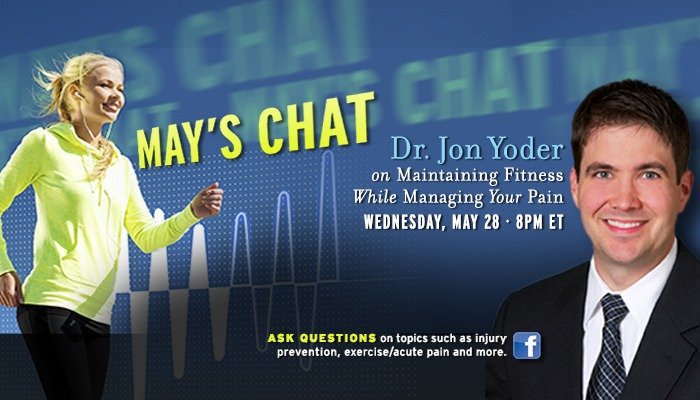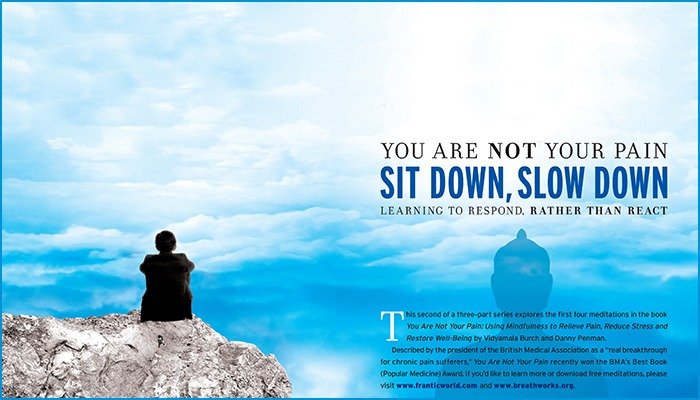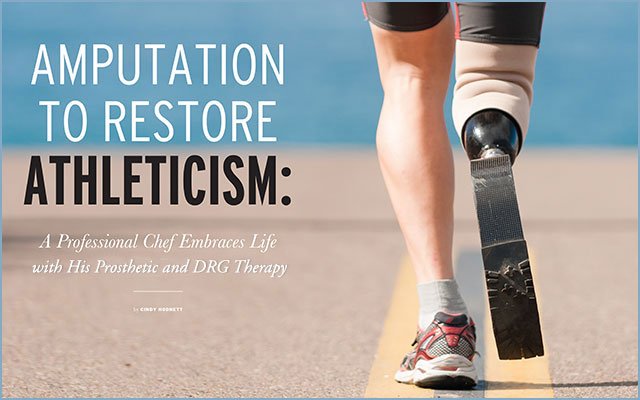Maintaining Fitness

Maintaining Fitness While Managing Your Pain
Transcripts Highlights
Dr. Yoder
May 28, 2014
Welcome! Thank you for joining us for “Maintaining Fitness While Managing Your Pain.” This chat will be hosted by Jon Yoder, MD, and will cover topics such as:
- How can exercise decrease pain?
- How can deconditioning worsen pain?
- How do I get started exercising?
- What exercises can I do?
- What is my “core” and why is it so important?
Jon Yoder, MD
Member of the American Medical
Dr. Yoder is a primary care sports medicine physician at Orthopedic Specialists of the Carolinas in Winston-Salem, NC. He is a member of the American Medical Society for Sports Medicine (AMSSM) and completed a family medicine residency and a primary care sports medicine fellowship. Dr. Yoder specializes in orthopedics and specializes in non-operative treatments. He is a firm believer in the importance of physical activity and tries to help his patients reach their activity goals whether it is to walk without pain or run a marathon.
Please join us in welcoming Dr. Yoder.
Dr. Yoder: Thanks for inviting me to this chat. It’s great to be here. I am excited to answer your questions as best I can.
Christina: How do I strengthen my core and exercise even though I have SI joint (back pain) problems.
Dr. Yoder: The “core” is where all movement starts, and it is our body’s center of gravity. It consists of 29 different muscles that attach to the lumbopelvic hip complex. Having a strong core is important for the transfer of strength and power from the lower extremities into the upper body. Having a weak core will increase your chances of hip, low back, neck, shoulder, and knee pain.
An easy way to incorporate core training into your workouts:
- Do not use stationary machines at the gym because they will deactivate your core stabilizer muscles.
- Free weight and body weight exercises will increase core strength and stabilization.
You don’t need fancy equipment. Using your bodyweight is usually enough. When people think of core training they most often think that they need to only do sit-ups. When I think of core training I think of pull-ups, pushup variations, squats, deadlifts, lunge variations, rowing, jumping, plyometrics, and plank variations, just to name a few. These exercises call upon many muscles to work at one time to produce movement, which is how the human body works efficiently.
Mel & Mary: How do you determine the best exercise program for you specifically?
Dr. Yoder: There are a lot of things to consider when you start an exercise program. Everyone has his or her own goals and abilities. I feel that the most important thing to do is find an activity that you enjoy. If it isn’t fun then you will never do it. I enjoy running so I run a lot. My wife enjoys the elliptical machine. Others prefer swimming or even walking
Walking, swimming, riding a stationary bike, water aerobics, or a rowing machine are all good aerobic exercise sources. Stretching exercises, yoga, and breathing exercises are good additions to aerobic exercises because they increase blood supply and nutrients to the joints, decrease the risk of injury, increase coordination, improve balance, and reduce stress in muscles.
Start by exercising one to two days per week. Initially, the daily duration could be as little as five minutes or less. Gradually build up to three to four times a week. After you have built up to three to four times a week, gradually increase the length of time for your exercise routine. Go from 5 minutes the first couple of weeks, to 10 minutes the next couple of weeks, to 15 minutes the next couple of weeks. Keep increasing the amount of time you exercise until you reach a goal of 30 straight minutes of aerobic activity three or more days per week. 30 minutes a day most days of the week is a good goal. You can even break up the 30 minutes into three 10-minute periods throughout the day.
The intensity of the exercise should only be increased after you have achieved your goal of 30 straight minutes of aerobic activity on most days of the week. After you have achieved the 30 minutes, you can begin increasing the intensity of your workouts.
Be gentle with yourself; listen to your body. Avoid the tendency to increase the amount or the intensity of your exercise on days when you are feeling well. If you overexert yourself, you will increase your risk of aggravating your symptoms.
Lisa: Piriformis stretches?
Dr. Yoder: It is hard to describe a good stretch in words. Pictures and video (or better yet, face-to-face with a therapist) are better. I just did a quick Google search and a few videos came up that describe the stretches I like.
Here are two examples:
Elena: What about soreness the day after exercise?
Dr. Yoder: That is a common issue in people starting a new activity. The symptoms should resolve over a period of a day and make sure not to return to the exercise while you are still sore. Staying hydrated can help prevent muscle soreness so make sure you “refill” after exercise. A good way to do that is to weigh yourself before and after an exercise and make sure you replace most of that weight loss with water or other recovery drink. Tylenol or ibuprofen can also be helpful for the symptoms. Make sure you don’t increase your intensity or duration of exercise until your body is used to the activity and the post-exercise soreness has improved.
Linda: Besides swimming (I’m afraid of water!), what kind of exercise do you recommend for someone with a chronic foot injury?
Dr. Yoder: My favorite low-impact cardiovascular exercise is an elliptical machine. You can get a better workout with an elliptical than with an exercise bike, and it produces less stress than running. There are also recumbent elliptical machines that stress the feet even less. If the elliptical causes pain then an exercise bike is another good option. If that still causes pain then you can even get a good cardio workout with yoga and many positions do not stress the foot at all.
Mel & Mary: I have severe fibromyalgia (all 18 trigger points). Will excess exercise make it worse?
Dr. Yoder: You might have some increase in pain initially because you will use muscles in a new way but that should be thought of as “good pain.” Exercise improves your pain threshold. With chronic pain, your pain threshold drops – in other words, it takes less pain to make you feel more uncomfortable. With cardiovascular, strengthening, and flexibility exercise, you can improve that pain threshold. Regular physical activity can help you not have to worry so much about the pain and still have energy left over for enjoying recreational activities.
Studies report that moderate exercise can decrease fatigue, pain, and stress. At the same time, it improves perceptions of your health, physical function, and aerobic fitness. Even low-intensity exercise like walking can improve symptoms.
Some people get frustrated when they start exercising because they develop pain, so they stop. If you are a patient with chronic pain, your body has probably already adapted to what is called a “pain cycle.” Pain cycles begin when you move your body or obtain a specific posture to avoid pain. Most often this causes you to move in a distorted way, and poor posture and unbalanced motion create more pain and possibly recurring injury. Breaking the pain cycle can be difficult, especially if the body has been in the cycle for a long time. Sometimes people feel like attempts at exercise are met with flare-up pain or worse symptoms, so it feels better to rest and avoid being active. This is not the case. Even if there is more discomfort in the beginning, retraining your body and remaining active will help long-term. Graded aerobic exercise is a first step in breaking the pain cycle, reducing pain and injury, and becoming more fit.
PainPathways: See our recent article on The Power of Exercise for Pain Management
Dr. Yoder: The hardest thing about exercising is getting started, but once you get started you will begin to see and feel the difference. Look at all the benefits of regular physical activity and/or exercise:
- Decreased pain
2. Decreased fatigue
3. Decreased number of tender points (joint and muscle pain)
4. Decrease in blood pressure
5. Decreased resting heart rate
6. Decreased risk for heart disease or stroke
7. Improved sleep
8. Decreased anxiety and depression
9. Increased efficiency of the heart
10. Increased control of blood sugar levels
11. Increased ability to burn fat
12. Improved physical fitness
13. Decreased loss of muscle strength and aerobic fitness
14. Increased energy
15. Improved cholesterol profile
16. Enhanced feeling of well-being
17. Enhanced performance of work and recreational activities
Exercise has benefits for everyone so make the commitment to yourself to get started in an exercise program. You will feel better, and you will feel better about yourself.
Dr. Yoder: To begin an exercise program, start by just gradually increasing your daily activity. For example, use any opportunity you have to do some extra walking, like simply not taking the closest parking spot. Other things you can do include:
Take the stairs whenever you can.
Get up more often and do some tasks around your home.
Limit your television and excessive computer/video game use (as this promotes inactivity).
PainPathways: If you’re concerned about children and sports-related injuries, here’s another article on our website to check out.
Dr. Yoder: If you have back or joint pain, there are probably some times when all you want to do is lie in bed all day. It’s tempting, but it might make the problem worse. Doctors used to prescribe bed rest for back pain and other chronic pain conditions, but studies have found that people who exercise and stay flexible manage their pain much better than those who don’t.
Monica: I get heel pain when I run, what should I do?
Dr. Yoder: It sounds a lot like plantar fasciitis, which is very common in runners. Simple things to start with are making sure you have an appropriate running shoe that hasn’t “worn out.” Running shoes should be replaced every 300-500 miles. A heel cushion from a local sporting goods store can be helpful. Rolling your heel on a frozen can of juice can help the pain. The seated plantar fascia stretch is a great thing to do in the morning or after being seated for a long time. Sometimes physical therapy or injection is needed if symptoms do not improve. The good thing is that it almost always goes away on its own eventually.
Cindy: I am battling knee osteoarthritis and it is keeping me from fun activities.
Dr. Yoder: I would recommend that you see your doctor about treatment options such as physical therapy, oral NSAIDs or Tylenol, cortisone injections, or viscosupplementation. The treatment depends on the severity of the OA and other medical problems. I find that PT is underutilized because most people want a quick fix, but PT might be the best long-term option because it will increase your strength and flexibility, which will be good in the long run.
Susan: I’m having problems with sciatica. I have CFS and fibromyalgia, I’m gaining weight due to a lack of work as a nurse. My mom says I need to walk more but my hip or rather a sciatica hurts more. I was told not to do things that irritate it, bending is the worst, but now walking makes it hurt. I’ve had x-rays, but I can’t have an MRI because I have a steel screw in my ankle that broke during surgery for broken femur and ankle, and that is the same leg I get sciatica in. Any ideas would help, thank you.
Dr. Yoder: Physical therapy might greatly benefit you. Increasing your core strength might help with your symptoms and help you tolerate exercise. Light weight-bearing exercises like swimming and elliptical are my help as well.
Gina: I exercise and still can’t lose any weight. I have fibromyalgia and chronic neck pain. Any ideas? Also, what is the best pain med for fibromyalgia?
Dr. Yoder: You can review my previous posts on starting an exercise program. The thing you have to think about with weight loss is that you will only lose weight if you burn more calories than you take in so make sure you are also watching your diet. You would have to talk with your doctor about medication options for fibromyalgia.
Valerie: I have fibro, hemicrania continua, and a host of associated things like IBS, gastro upset, etc. It is so hard to work out because of the constant pain. I can walk or bike for a few weeks, then when the pain is high, I can’t do anything. Guess I’m just voicing my frustration!
Dr. Yoder: I can understand you are frustrated. Please look at the posts above about starting an exercise program. It might hurt a little at first but stick with it because you will be much better off in the long run.
PainPathways: To test your knowledge – Take our Sports & Pain Quiz
Sports and Pain – Quiz – PainPathways Magazine
PainPathways: We appreciate all of your thoughtful questions and our experts’ informative responses. This has been a great dialogue.
This is Amy North, managing editor of PainPathways Magazine. On behalf of our editor-in-chief, Dr. Richard Rauck, we thank Dr. Jon Yoder and all those who participated in tonight’s chat. We are excited to be offering this great forum for information and inspiration. Have a good night everyone!
PainPathways Magazine
PainPathways is the first, only and ultimate pain magazine. First published in spring 2008, PainPathways is the culmination of the vision of Richard L. Rauck, MD, to provide a shared resource for people living with and caring for others in pain. This quarterly resource not only provides in-depth information on current treatments, therapies and research studies but also connects people who live with pain, both personally and professionally.
View All By PainPathways






